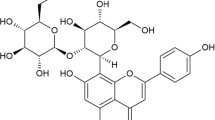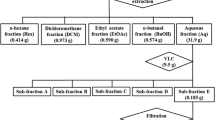Abstract
Information on the health benefits of ethanolic extracts obtained from Blutaparon portulacoides stem (EEBP) hasn´t been consistently described in the literature until the present moment. This study investigated the antimycobacterial, anti-inflammatory and toxicological effects of EEBP in models of inflammation/infection, as well as its chemical composition. Chemical analysis of EEBP by electrospray ionization–mass spectrometry/HPLC–MS/MS identified 3,5,3′-Trihydroxy-4′-methoxy-6,7-methylenedioxy-flavone, gomphrenol, ferulic, vanillic, and caffeic acids. The minimum inhibitory concentration of EEBP and isoniazid in the presence of Mycobacterium tuberculosis was 123.4 and 0.030 µg/ml, respectively. EEBP oral administration (p.o.) (300–1000 mg/kg) or dexamethasone subcutaneous injection (s.c.) (1 mg/kg) significantly inhibited leukocytes and proteins resulting from carrageenan-induced pleurisy in Swiss mice. In the BCG-induced pleurisy model, the oral treatments performed once a day for 7 days, with EEBP (30 and 100 mg/kg) and isoniazid (25 mg/kg), inhibited the increase in plasmatic IL-1β levels and in pleural exudate from C57BL-6 mice, and reduced M. tuberculosis growth in organs (colony forming units assays). EEBP (30–300 mg/kg, p.o.) and dexamethasone (1 mg/s.c.) significantly prevented carrageenan-induced oedema and mechanical hyperalgesia in Swiss mice. The treatments (once a day for 22 days) with EEBP (30 mg/kg, p.o.) and dexamethasone (1 mg/s.c.) substantially inhibited oedema and mechanical- and cold-hyperalgesia at 11, 16 and 22 days after the administration of Freund's Complete Adjuvant in C57bL6 mice. No evidence of physio-pathologic was observed in Wistar rats acutely treated with EEBP (2000 mg/kg, p.o.). This study confirms the anti-inflammatory and antibiotic properties of EEBP, opening possibilities for the development of safe new drugs with dual anti-inflammatory/antimycobacterial activities which could be favorable from a pharmacoeconomic perspective.







Similar content being viewed by others
References
Andrew D, Greenspan JD (1999) Mechanical and heat sensitization of cutaneous nociceptors after peripheral inflammation in the rat. J Neurop 82:2649–2656
Andrade M, Benfeito S, Soares P et al (2015) Fine-tuning of the hydrophobicity of caffeic acid: studies on the antimicrobial activity against Staphylococcus aureus and Escherichia coli. Roy Soc Chem Advanc 5:53915–53925
Bertier RM, Dias RVC, Batista JS, Soto-Blanco B (2008) Intoxicação por pirrixiu (Blutaparon portulacoides) em ovinos. Arq Inst Biol 99–102
Bourigault M-L, Segueni N, Rose S et al (2013) Relative contribution of IL-1α, IL-1β and TNF to the host response to Mycobacterium tuberculosis and attenuated M. bovis BCG. Immun Inflamm Dis 1:47–62
Brasil. Ministério da Saúde (2009) Portal da Saúde. Programa Nacional de Plantas Medicinais e Fitoterápicos. https://portalsaude.saude.gov.br/images/pdf/2015/janeiro/05/ programa-nacional-plantas-medicinais-fitoter--picos-pnpmf.pdf
Cain DW, Cidlowski JA (2017) Immune regulation by glucocorticoids. Nat Rev Immunol 17:233–247
Campos F, Santos UP, Macorini LFB et al (2014) Antimicrobial, antioxidant and cytotoxic activities of propolis from Melipona orbignyi (Hymenoptera, Apidae). Food Chem Toxicol 65:374–380
Choi JH, Park SH, Jung JK et al (2017) Caffeic acid cyclohexylamide rescues lethal inflammation in septic mice through inhibition of IκB kinase in innate immune process. Sci Report 41180
Cholo MC, Steel HC, Fourie PB et al (2012) Clofazimine: Current status and future prospects. J Antimicrob Chemotherap 67:290–298
Choudhary S, Mourya A, Ahuja S et al (2016) Plausible anti-inflammatory mechanism of resveratrol and caffeic acid against chronic stress-induced insulin resistance in mice. Inflammopharmacol 24:347–361
Curfs JH, Meis JFJ, Hoogkamp-Korstange A (1997) A primer on cytokines: sources, receptors, effects, and inducers. Clinic Microb Rev 10:742–780
Cynamon MH, Zhang Y, Harpster T, Cheng S, DeStefano MS (1999) High-dose isoniazid therapy for isoniazid-resistant murine Mycobacterium tuberculosis infection. Antimicrob Agents Chemother 43(12):2922–2924
Decosterd I, Woolf CJ (2000) Spared nerve injury: an animal model of persistent peripheral neuropathic pain. Pain 87(2):149–158
Dey D, Ray R, Hazra B (2015) Antimicrobial activity of pomegranate fruit constituents against drug-resistant Mycobacterium tuberculosis and β-lactamase producing Klebsiella pneumoniae. Pharm Biol 53(10):1474–1480
Di Rosa ML, Giroud JP, Willoughby DA (1971) Studies of the mediators of the acute inflammatory response induced in rats in different sites by carrageenan and turpentine. J Pathol 104(1):15–29
Ferreira EO, Dias DA (2000) A methylenedioxyflavonol from aerial parts of Blutaparon portulacoides. Phytochemistry 53(1):145–147
Ferreres F, Gil-Izquierdo A, Valentão P, Andrade PB (2011) Structural characterization of phenolics and betacyanins in Gomphrena globosa by high-performance liquid chromatography-diode array detection/electrospray ionization multi-stage mass spectrometry. Rapid Commun Mass Spectrom 25(22):3441–3446
Genestet C, Ader F, Pichat C et al (2017) Assessing the combined antibacterial effect of isoniazid and rifampin on four Mycobacterium tuberculosis strains using In Vitro experiments and response-surface modeling. Antimicrob Agents Chemother 62(1):e01413–e1417
Khan SR, Manialawy Y, Siraki AG (2019) Isoniazid and host immune system interactions: A proposal for a novel comprehensive mode of action. Br J Pharmacol 176(24):4599–4608
Krishnan N, Robertson BD, Thwaites G (2013) Pathways of IL-1β secretion by macrophages infected with clinical Mycobacterium tuberculosis strains. Tuberc (Edinb) 93(5):538–547
Kuraoka-Oliveira AM, Radai JAS, Leitão MM, Lima Cardoso CA, Silva-Filho SE, Leite Kassuya CA (2020) Anti-inflammatory and anti-arthritic activity in extract from the leaves of Eriobotrya japonica. J Ethnopharmacol 249:112418
Lampiasi N, Montana G (2018) An in vitro inflammation model to study the Nrf2 and NF-κB crosstalk in presence of ferulic acid as modulator. Immunobiology 223:349–355
Liu YM, Shen JD, Xu LP et al (2017) Ferulic acid inhibits neuro-inflammation in mice exposed to chronic unpredictable mild stress. Int Immunopharmacol 45:128–134
Maresca A, Vullo D, Scozzafava A et al (2013) Inhibition of the β-class carbonic anhydrases from Mycobacterium tuberculosis with carboxylic acids. J Enzyme Inhib Med Chem 28(2):392–396
Marmitt DJ, Bitencourt S, Silva ADCE et al (2018) The healing properties of medicinal plants used in the Brazilian public health system: a systematic review. J Wound Care 27(Sup6):S4–S13
Marson CV, Boas EV, Zamuner S, Salvador MJ (2009) Preparo de uma formulação tópica e avaliação antiinflamatória do extrato Blutaparon portulacoides. In: XIII Encontro Latino de Iniciação Científica, IX Encontro Latino Americano de Pós Graduação e III Encontro Latino de Iniciação Científica Junior
Mathur S, Hoskins C (2017) Drug development: Lessons from nature. Biomed Report 6:612–614
Morris CJ (2003) Carrageenan-induced paw edema in the rat and mouse. Methods Mol Biol 225:115–121
National Committee for Clinical Laboratory Standards (NCCLS) (2002) Performance standards for antimicrobial susceptibility testing. Inf Supplements. 100–112
Nikonenko BV, Bocharova IV, Korotetskaya MV, Averbakh MM, Apt AS (2017) Efficacy of isoniazid therapy in mice with different genetic susceptibility to infection. Mycobact Dis 7(4):1–4
OECD (2008) Organisation for Economic Co-operation and Development In: CHEMICALS, O. G. F. T. T. O. (Ed.). Guideline 425: Acute Oral Toxicity – Up-and-Down-Procedure (UDP), Paris: Head of Publications Service, 27
Oliveira DBD, de Almeida AP, Gabriela L et al (2003) First isolation of a symmetrical glycosylated methylene bis flavonoid. Planta Med 69(04):382–384
Palomino JC, Martin A, Camacho M et al (2002) Resazurin microtiter assay plate: simple and inexpensive method for detection of drug resistance in Mycobacterium tuberculosis. Antimicrob Agents Chemother 46(8):2720–2722
Pereira IC, Barbosa AM, Salvador MJ et al (2009) Anti-inflammatory activity of Blutaparon portulacoides ethanolic extract against the inflammatory reaction induced by Bothrops jararacussu venom and isolated myotoxins BTHTX-I and II. J Venom Anim Toxins incl Trop Dis 15(3):527–545
Pio IDSL, Lavor AL, Damasceno CMD et al (2019) Traditional knowledge and uses of medicinal plants by the inhabitants of the islands of the São Francisco river, Brazil and preliminary analysis of Rhaphiodon echinus (Lamiaceae). Braz J Biol 79:87–99
Posadas I, Bucci M, Roviezzo F et al (2004) Carrageenan-induced mouse paw oedema is biphasic, age-weight dependent and displays differential nitric oxide cyclooxygenase-2 expression. Br J Pharmacol 142(2):331–338
Salvador MJ, Ferreira EO, Pral EM et al (2002) Bioactivity of crude extracts and some constituents of Blutaparon portulacoides (Amaranthaceae). Phytomedicine 9(6):566–571
Salvador MJ, Andreazza NL, Pascoal ACRF et al (2012) Bioactive chemical constituents and biotechnological production of secondary metabolites in Amaranthaceae Plants. Bentham Science Publishers Ltd, Gomphreneae Tribe. Benth
Saleem U, Amin S, Ahmad B et al (2017) Acute oral toxicity evaluation of aqueous ethanolic extract of Saccharum munja Roxb. roots in albino mice as per OECD 425 TG. Toxicol Reports 31:580–585
Siqueira JC (1987) Importância alimentícia e medicinal das amarantáceas do Brasil. Act Biologica Leopold 09:99
Spargo CA, Haaland PD, Jurgensen SR et al (1993) Chemiluminescent detection of strand displacement amplified DNA from species comprising the Mycobacterium tuberculosis complex. Mol Cell Probes 7(5):395–404
Teskey G, Cao R, Islamoglu H et al (2018) The synergistic effects of the glutathione precursor, NAC and first-line antibiotics in the granulomatous response against Mycobacterium tuberculosis. Front Immunol 9:2069
Tseng CH, Tung CW, Wu CH et al (2017) Discovery of Indeno[1,2-c]quinoline derivatives as potent dual antituberculosis and anti-inflammatory agents. Molecules 22:1–15
Vinegar R, Truax JF, Selph JL (1973) Some quantitative temporal characteristics of carrageenin-induced pleurisy in the rat. Proc Soc Exp Biol Med 143(3):711–714
Vivancos GG, Verri WA, Cunha TM et al (2004) An electronic pressure-meter nociception paw test for rats. Braz J Med Biol Res 37(3):391–399
Xiahou Z, Wang X, Shen J et al (2017) NMI and IFP35 serve as proinflammatory DAMPs during cellular infection and injury. Nat Commun 8(1):950
Yrbas ML, Morucci F, Alonso R, Gorzalczany S (2015) Pharmacological mechanism underlying the antinociceptive activity of vanillic acid. Pharmacol Biochem Behav 132:88–95
Zhang JM, An J (2007) Cytokines, inflammation and pain. Int Anesthesiol Clin 45:27–37
Zhou Y, Jiao Y, Wei YH et al (2013) Effects of pyridoxine on the intestinal absorption and pharmacokinetics of isoniazid in rats. Eur J Drug Metab Pharmacokinet 38(1):5–13
Acknowledgements
The authors would like to thank National Council for Scientific and Technological Development (CNPq), Fundação de Amparo à Pesquisa e ao Desenvolvimento Científico e Tecnológico do Mato Grosso do Sul (FUNDECT), and Coordination for the Improvement of Higher Education Personnel (CAPES), Fund for Support to Teaching, Research and Outreach Activities of University of Campinas (FAEPEX-UNICAMP).
Funding
This work was funded by FAPESP- Fundação de Amparo à Pesquisa do Estado de São Paulo (Proc. 15/03,726–8 and 06/06,079–4).
Author information
Authors and Affiliations
Corresponding author
Ethics declarations
Conflict of interest
The author(s) confirm that this article content has no conflicts of interest.
Additional information
Publisher's Note
Springer Nature remains neutral with regard to jurisdictional claims in published maps and institutional affiliations.
Rights and permissions
About this article
Cite this article
Kassuya, R.M., Radai, J.A.S., Macorini, L.F.B. et al. Blutaparon portulacoides ethanolic extract reduced IL-1β and inflammatory parameters induced by the Mycobacterium complex and carrageenan in mice. Inflammopharmacol 29, 439–450 (2021). https://doi.org/10.1007/s10787-020-00752-0
Received:
Accepted:
Published:
Issue Date:
DOI: https://doi.org/10.1007/s10787-020-00752-0




